 image by Rob
Raeside, 19 May 2010
image by Rob
Raeside, 19 May 2010
Last modified: 2014-06-14 by ian macdonald
Keywords: ashanti | variation | throne | star: 5 points (white on red) | cross (yellow) | chevron (yellow) |
Links: FOTW homepage |
search |
disclaimer and copyright |
write us |
mirrors
According to my files the flag of the Ashanti has several variations.
Sources are McMeekin [mee03] and the
Fachinger-collection [fcgXX] at the Museum
at Bremerhafen (DE).
Falko Schmidt, 16 February 2001
Yellow over black over green horizontal stripes with a yellow device
in the black stripe.
Falko Schmidt, 16 February 2001
 image by Falko Schmidt, 02 March 2001
image by Falko Schmidt, 02 March 2001
Yellow over black over green horizontal stripes with small white
fimbriations between the stripes and a yellow throne-emblem in the
middle stripe.
Falko Schmidt, 16 February 2001
 image by Falko Schmidt, 02 March 2001
image by Falko Schmidt, 02 March 2001
Flags used by uprisings: yellow with a green-white-black horizontal
striped first quarter.
Falko Schmidt, 16 February 2001
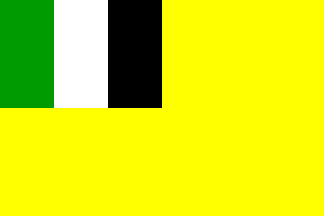 image by Falko Schmidt, 02 March 2001
image by Falko Schmidt, 02 March 2001
Flags used by uprisings: yellow with a green-white-black vertical
striped first quarter.
Falko Schmidt, 16 February 2001
 image by Falko Schmidt, 02 March 2001
image by Falko Schmidt, 02 March 2001
According to Nations Without States
[mnh96], the flag of Ashanti national
movement is a horizontal tricolor of red, yellow,
green with a five-pointed white star in the upper hoist. I’m not
sure where the author obtained his information, but perhaps the flag is that
of some contemporary Ashanti political movement.
Ned Smith, 16 February 2001
The flags below were reported as "flags from the Gold Coast", with no further attribution.
 image by Rob
Raeside, 19 May 2010
image by Rob
Raeside, 19 May 2010
Sefwi Anhwiaso, from arms.
John McMeekin, 19 May 2010
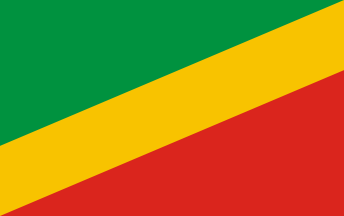 image by Rob
Raeside, 19 May 2010
image by Rob
Raeside, 19 May 2010
Hohoe.
John McMeekin, 19 May 2010
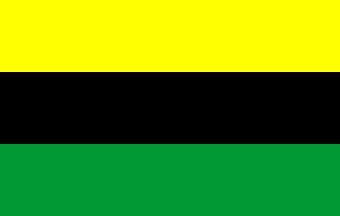 image by Rob
Raeside, 19 May 2010
image by Rob
Raeside, 19 May 2010
Ashanti.
John McMeekin, 19 May 2010
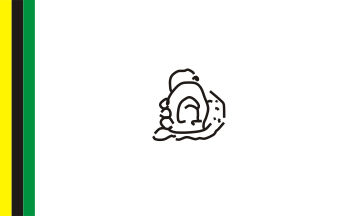 image by Rob
Raeside, 19 May 2010
image by Rob
Raeside, 19 May 2010
Ashanti Personal Standard. Not sure what the line object is, but I
reproduced faithfully from John's sketch.
John McMeekin, 19 May 2010
 image by Rob
Raeside, 19 May 2010
image by Rob
Raeside, 19 May 2010
Akwamu.
John McMeekin, 19 May 2010
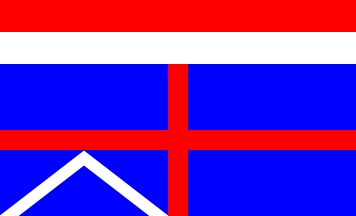 image by António
Martins-Tuválkin, 22 December 2006
image by António
Martins-Tuválkin, 22 December 2006
It is a plain flag with a cross a little bit thinner
than usual. In the lower hoist is a chevron.
Klaus-Michael Schneider, 30 March 2006
The upper stripes seem to be stripes and not a red streamer, for they fly in
unison with flag and show the same texture and shading.
António
Martins-Tuválkin, 22 December 2006
In the Nationalmusset Copenhagen you can the a coloured
copperplate-engraving, showing the Ashantis yams-feast in September of
estimated 1740-1745. It was a fairly bloody event, for the Ashanti-King
killed a slave, each time when an important person arrived, just to
honour the guest. The so called highlight was a mass-slaughter at the
end of the event.
Klaus-Michael Schneider, 30 March 2006
You can see in the engraving big red parasols, the Ashanti-kings used
instead of flags, as well as Dutch, British and Danish flags. There is
however an unknown flag partially hidden by white objects. I don’t
know, whether the flag is topped by a thin red pennant or not.
Two versions are possible: plain (excl. pennant) or
with stripes. (Source: Per EILSTRUP &
Nils Eric BOESGAARD Fjernt fra Danmark, Copenhagen
1974: p.112-113.)
Klaus-Michael Schneider, 30 March 2006
Another version of the same portrait would seem to make it that the flag is
blue:
http://hitchcock.itc.virginia.edu/SlaveTrade/collection/large/bow-yam.JPG.
Also, the other 3 flags are repeated a few time but not this one, could it be
simply decorative?
Marc Pasquin, 1 April 2006
The cross is red, not yellow. The upper red stripe seems to flutter in unison
with the blue/black area of the flag: not a red pennant hoisted above the flag
against a white sky, but two top stripes, red and white.
António
Martins-Tuválkin, 2 April 2006
In addition to the that and the point António made about the cross
being red not gold, it should be noted that another website, referring to the
above image, dates the event to 1817, not the originally reported 1745 or so.
See
http://web.grinnell.edu/courses/his/s05/his105-01/Slideshows/1600_Slavery_files/frame.htm#slide0040.htm.
That may make a difference in identifying the flag [even if the author of the
webpage can't tell the difference between the Dutch and French flags - the
British flag does have the St. Patrick's cross so the image was definitely
produced post 1801].
Ned Smith, 2 April 2006
I stumbled across yet another color variant of this same image. In this one
the chevron is clearly gold and the cross is pinkish, distinctly lighter than
the red of the top stripe (in fact at a quick glance, at certain lighting angles
the cross might even be mistaken for pale gold, perhaps accounting for our
original correspondent reporting both cross and chevron as gold).
This
example was from a two-page illustration in The Horizon History of Africa (New
York: American Heritage Publishing Co.; 1971: ISBN 07-030342-8) at the top of
pages 392-393. According to the caption the illustration, which a website*
describes as a colored lithograph, was taken from Thomas Bowditch's 1819 book
"Mission from Cape Coast Castle to Ashante", and that the festival it depicts
was "seen and sketched by Thomas Bowditch" in 1817.
And just as a further
thought- since the illustration was apparently done for the publication, and
possibly commissioned by a publishing firm and not the author/artist, it raises
the question of how much input the colorist had from Bowditch.
*
http://www.bridgeman.co.uk/search/view_image2.asp?image_id=234075&tmp= The
Bridgeman Art Library Image Search Title The First day of the Yam Custom, from
'Mission from Cape Coast Castle to Ashantee', engraved by Robert Havell,
published London 1819 (colour litho), Artist Bowditch, Thomas E (fl.1819)
Location © Lambeth Palace Library, London, UK
Medium colour lithograph
Century C19th
Ned Smith, 28 December 2006